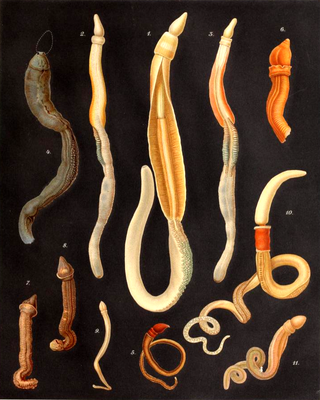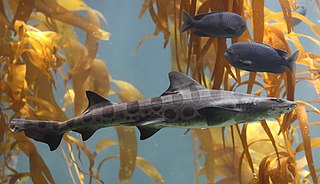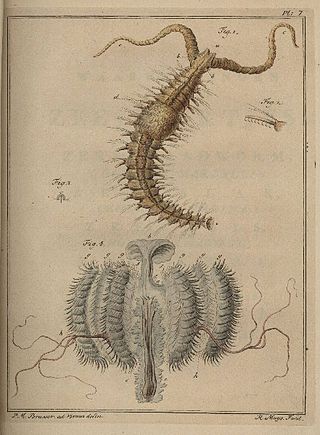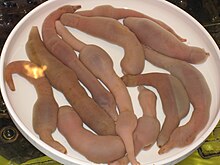
The Sipuncula or Sipunculida is a class containing about 162 species of unsegmented marine annelid worms. Sipuncula was once considered a phylum, but was demoted to a class of Annelida, based on recent molecular work.

The Echiura, or spoon worms, are a small group of marine animals. Once treated as a separate phylum, they are now considered to belong to Annelida. Annelids typically have their bodies divided into segments, but echiurans have secondarily lost their segmentation. The majority of echiurans live in burrows in soft sediment in shallow water, but some live in rock crevices or under boulders, and there are also deep sea forms. More than 230 species have been described. Spoon worms are cylindrical, soft-bodied animals usually possessing a non-retractable proboscis which can be rolled into a scoop-shape to feed. In some species the proboscis is ribbon-like, longer than the trunk and may have a forked tip. Spoon worms vary in size from less than a centimetre in length to more than a metre.

The acorn worms or Enteropneusta are a hemichordate class of invertebrates consisting of one order of the same name. The closest non-hemichordate relatives of the Enteropneusta are the echinoderms. There are 111 known species of acorn worm in the world, the main species for research being Saccoglossus kowalevskii. Two families—Harrimaniidae and Ptychoderidae—separated at least 370 million years ago.

Hoe is a traditional Korean seafood dish that is eaten by trimming raw meat or raw fish. In addition to fish, it is also made with other marine products such as shrimp and squid, raw meat of land animals, and vegetable ingredients, but without any special prefix, it mainly refers to raw fish. It is called Sukhoe that is blanched by applying heat. It has been a favorite food since the Three Kingdoms of Korea, and is one of the oldest foods in Korean history. This is because in the early Paleolithic era, when fire was not available, it was not cooked no matter how it was eaten.

The leopard shark is a species of houndshark, in the family Triakidae. It is found along the Pacific coast of North America, from the U.S. state of Oregon to Mazatlán in Mexico. Typically measuring 1.2–1.5 m (3.9–4.9 ft) long, this slender-bodied shark is immediately identifiable by the striking pattern of black saddle-like markings and large spots over its back, from which it derives its common name. Large schools of leopard sharks are a common sight in bays and estuaries, swimming over sandy or muddy flats or rock-strewn areas near kelp beds and reefs. They are most common near the coast, in water less than 4 m (13 ft) deep.

A bottom feeder is an aquatic animal that feeds on or near the bottom of a body of water. Biologists often use the terms benthos—particularly for invertebrates such as shellfish, crabs, crayfish, sea anemones, starfish, snails, bristleworms and sea cucumbers—and benthivore or benthivorous, for fish and invertebrates that feed on material from the bottom. However the term benthos includes all aquatic life that lives on or near the bottom, which means it also includes non-animals, such as plants and algae. Biologists also use specific terms that refer to bottom feeding fish, such as demersal fish, groundfish, benthic fish and benthopelagic fish. Examples of bottom feeding fish species groups are flatfish, eels, cod, haddock, bass, grouper, carp, bream (snapper) and some species of catfish, sharks.

A radiole is a heavily ciliated feather-like tentacle found in highly organized clusters on the crowns of Canalipalpata. Canalipalpata is an order of sessile marine polychaete worms consisting of 31 families. These benthic annelid tube worms employ radioles primarily for alimentation. While their primary role is to function as an organ for filter feeding, radioles also serve as respiratory organs. Because of their role in gas exchange, radioles are often referred to as "gills".

Scleroplax is a genus of crabs in the family Pinnotheridae.

Chaetopterus variopedatus is a species of parchment worm, a marine polychaete in the family Chaetopteridae. It is found worldwide. However, recent discoveries from molecular phylogeny analysis show that Chaetopterus variopedatus sensu Hartman (1959) is not a single species.
Listriolobus pelodes is a species of marine spoon worm. It is found in shallow seas in the North East Pacific off the coast of California. It lives in a burrow in soft sediments.
The penis is the male sex organ.

Hediste diversicolor, commonly known as a ragworm, is a polychaete worm in the family Nereididae. It lives in a burrow in the sand or mud of beaches and estuaries in intertidal zones in the north Atlantic. This species is used in research, but its classification is in dispute; in the literature, it is often classified as Nereis diversicolor. Its specific name "diversicolor" refers to the fact that its colour changes from brown to green as the breeding season approaches.

The arrow goby is a species of goby native to marine and brackish waters of the Pacific coast of North America from British Columbia to Baja California. This species grows to a length of 6.4 centimetres (2.5 in) SL, though most do not exceed 4.2 centimetres (1.7 in) TL. This fish can also be found displayed in public aquaria. This species is the only known member of its genus.
Fat innkeeper worm may refer to:

Polydora ciliata is a species of annelid worm in the family Spionidae, commonly known as a bristleworm. It is a burrowing worm and is found in the northeastern Atlantic Ocean and some other parts of the world.
Saccoglossus bromophenolosus is a species of acorn worm occurring in the northwestern Atlantic Ocean and the northeastern Pacific Ocean. It grows to a length of about 20 cm (8 in) and lives in a burrow in soft sediment in the intertidal and subtidal zones. The scientific name refers to 2,4-dibromophenol, a secondary metabolite present in this worm.

Urechidae is a family of spoonworms in the subclass Echiura. The only genus in the family is Urechis, which has four species.

Urechis caupo is a species of spoon worm in the family Urechidae, commonly known as the innkeeper echiuran, the fat innkeeper worm, the innkeeper worm, or the penis fish. It is found in shallow water on the west coast of North America, between southern Oregon and Baja California, where it forms a U-shaped burrow in the sediment and feeds on plankton using a mucus net.

Ochetostoma erythrogrammon is a species of spoon worm in the family Thalassematidae. It is found in shallow water in the Atlantic Ocean, the Mediterranean Sea, and the Indian and Pacific Oceans, burrowing in soft sediment.
















